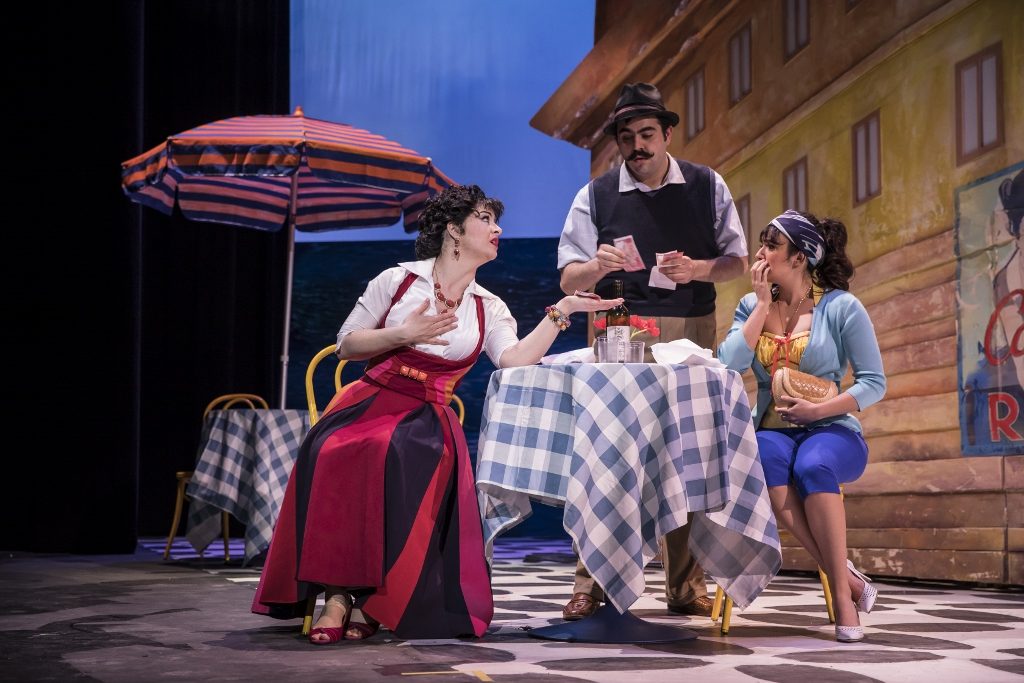MY FAIR SIGNORA,
OR DONIZETTI, SOUP TO NUTS
He didn’t just write Lucia di Lammermoor, Don Pasquale, L’Elisir d’Amore, Poliuto, The Daughter of the Regiment, Maria Stuarda, Roberto Devereux, Anna Bolena and much more. Gaetano Donizetti could write small and he started early: A fascinating, brilliantly mounted double bill, Chicago Opera Theater’s third and last Studebaker Theater offering of its season is a spring romp to start the flowers growing: It combines the maestro’s first opera with a much more characteristic later one written a quarter century later. In Amy Hutchison’s clever combination their stories are loosely contrasted and connected as first passion and tested love.
Happily and musically (perfectly shaped by Francesco Milioto), they also testify to Donizetti’s growth and range: Il Pigmalione, a two-singer treatment of Ovid’s legend of Pygmalion and Galatea, betrays the influences on the budding 19-year-old composer of Rossini, Mozart, Cherubini, Cimarosa and PaisÃello, while the latter, vintage Donizetti, even anticipates Offenbach and Bizet.
The result is a feast of bel canto beauty that, almost two centuries later, is guaranteed to feel new even to the most rabid Donizetti devotees. Drawing from the same work that inspired Pygmalion, My Fair Lady and A Touch of Venus, Il Pigmalione is a 40-minute one-act in which the obsessed title artist (heavenly Puerto Rico tenor Javier Abreu) is toiling at the turn of the last century, surrounded by images of the unknown beloved who haunts his work. Pigmalione struggles to capture ideal beauty in deathless marble. (Ingeniously implanted video sections from John Boesche and lighting changes by Ted Nazarowski tease his aspirations with hints of life.)
His wish is granted as soprano Angela Morellaro (a treasure with a voice) comes to life as Galatea. After so many non-stop tenor arias (inevitably harking back to 18th-century melodic wellsprings), it’s a treat to have a duet as charming as the teenage opera writer could conceive.
During the busy intermission, oafish “zanni” jugglers and buffoons, directed by Chicago clown teacher and physical theater expert Adrian Danzig, pretend to change the set as they indicate the passage of time to the 1950s. It’s an entr’acte filled with Keystone-comedy mugging and commedia dell’arte antics.
The real set change, William Boles’ triumph of scenic make-believe, opens up a chiaroscuro and Fellini-esque fantasy centered on the neon-lit Caffé Rita (Galatea’s new name), a seaside albergo on the Italian Riviera. There Rita (Mortellaro, now exuding feminist independence and matronly control) bosses around her cowed but devoted second hubbie Beppe (Abreu imitating a bumptious Roberto Benigni).
Confusion and chaos erupt when Rita’s abusive first husband Gasparo (baritone Keith Phares), who did not drown at sea, returns to discover that his first wife Rita did not burn to death. Immediately the two potentially bigamous “husbands” play cards and other strategies to see which one can lose Rita, a not very cavalier reaction to this very leading lady.
Rita is plunged into her own buyer’s remorse over two makeshift marriages. Charming duets and trios (but, alas, no chorus numbers) help these opposing points on a human triangle to sort things out. Leave it to Donizetti’s melodic musical mastery to both pit lovers apart and reconcile them in literal harmony. The former statue and her no longer demented stalker/creator have grown up, rising to their occasions along with Donizetti’s deathless mellowness and merriment.
In a bit more than two hours Chicago Opera Theater’s enchanted matched set, a Chicago first, delivers an opera lover’s dreams on a golden platter. Thanks to three splendid singers, Donizetti has come full circle in his abundant artistry. Suddenly 2018 feels a lot more bearable.
Il Pigmalione & Rita
Chicago Opera Theater
Studebaker Theater, 410 S. Michigan Ave.
ends on April 22, 2018
for tickets, call 312.704.8414 or visit COT
for more shows, visit Theatre in Chicago














